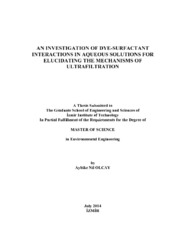Please use this identifier to cite or link to this item:
https://hdl.handle.net/11147/4239Full metadata record
| DC Field | Value | Language |
|---|---|---|
| dc.contributor.advisor | Polat, Mehmet | - |
| dc.contributor.advisor | Polat, Hürriyet | - |
| dc.contributor.author | Olcay, Aybike Nil | - |
| dc.date.accessioned | 2014-12-05T08:12:41Z | - |
| dc.date.available | 2014-12-05T08:12:41Z | - |
| dc.date.issued | 2014-07 | - |
| dc.identifier.uri | http://hdl.handle.net/11147/4239 | - |
| dc.description | Thesis (Master)--Izmir Institute of Technology, Environmental Engineering, Izmir, 2014 | en_US |
| dc.description | Includes bibliographical references (leaves: 53-56) | en_US |
| dc.description | Text in English; Abstract: Turkish and English | en_US |
| dc.description | Full text release delayed at author's request until 2017.08.11 | en_US |
| dc.description.abstract | Low Molecular Weight Contaminants (LMWCs) in waters are serious environmental concern due to removal problems with classical techniques such as chemical coagulation, biological treatments and adsorption. LMWCs are usually copresent with surface active agents in contaminated waters. Though such advanced removal techniques as ultrafiltration and micelle enhanced ultrafiltration are said to perform better, no systematic study is present for elucidating how the contaminantsurfactants interactions affect removal efficiency. In this study, methylene blue (MB), a dye widely employed in textile, paper and chemical industries, was chosen as the model contaminant. Surfactants selected were anionic sodium dodecyl sulfate (SDS), cationic hexadecyltrimethyl ammonium bromide (CTAB) and non-ionic ethoxylated octylphenol (TX-100). Surface tension, size, charge and contact angle measurements were conducted to investigate dye-surfactant interactions. Cellulose nitrate filters were employed to determine the effect of these interactions in filtration efficiency. It was found that significant amount of MB was removed from solution since it attached on the negatively charged cellulose nitrate filter. Though presence of surfactants generally decreased MB removal efficiency, MB-SDS interaction created large-loose aggregates at low SDS concentrations which cannot pass the filter paper. The MB-CTAB/TX-100 interactions created positively charged MB-surfactant pairs which can attach to the filter surface causing a decrease in the removal. At concentrations above Critical Micelle Concentration (CMC), the efficiency of MB removal is low due to the formation of surfactant-micelles that are smaller than the pores of the filter. Detailed size distribution experiments suggest that MB molecules are within the micelles structure, not in the core as believed in literature and do not increase the size of the micelle. | en_US |
| dc.language.iso | en | en_US |
| dc.publisher | Izmir Institute of Technology | en_US |
| dc.rights | info:eu-repo/semantics/openAccess | en_US |
| dc.subject | Low molecular weight contaminants | en_US |
| dc.subject | Critical micelle concentration | en_US |
| dc.subject.lcsh | Water--Purification--Adsorption | en_US |
| dc.title | An Investigation of Dye-Surfactant Intetactions in Aqueous Solutions for Elucidating the Mechanisms of Ultrafiltration | en_US |
| dc.title.alternative | Sulu Çözeltilerde Boya-sürfaktan Etkileşimlerinin Ultrafiltrasyon Mekanizmasının Aydınlatılması Amacıyla İncelenmesi | en_US |
| dc.type | Master Thesis | en_US |
| dc.institutionauthor | Olcay, Aybike Nil | - |
| dc.department | Thesis (Master)--İzmir Institute of Technology, Environmental Engineering | en_US |
| dc.relation.publicationcategory | Tez | en_US |
| dc.identifier.wosquality | N/A | - |
| dc.identifier.scopusquality | N/A | - |
| item.openairecristype | http://purl.org/coar/resource_type/c_18cf | - |
| item.cerifentitytype | Publications | - |
| item.languageiso639-1 | en | - |
| item.grantfulltext | open | - |
| item.fulltext | With Fulltext | - |
| item.openairetype | Master Thesis | - |
| Appears in Collections: | Master Degree / Yüksek Lisans Tezleri Sürdürülebilir Yeşil Kampüs Koleksiyonu / Sustainable Green Campus Collection | |
Files in This Item:
| File | Description | Size | Format | |
|---|---|---|---|---|
| 10034933.pdf | MasterThesis | 1.09 MB | Adobe PDF |  View/Open |
CORE Recommender
Page view(s)
228
checked on Apr 14, 2025
Download(s)
184
checked on Apr 14, 2025
Google ScholarTM
Check
Items in GCRIS Repository are protected by copyright, with all rights reserved, unless otherwise indicated.